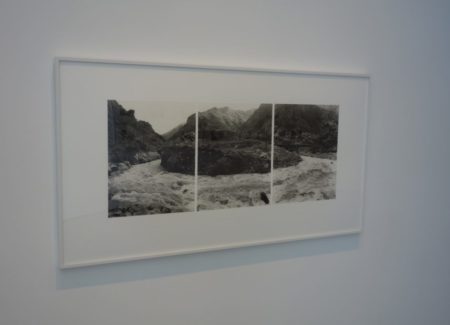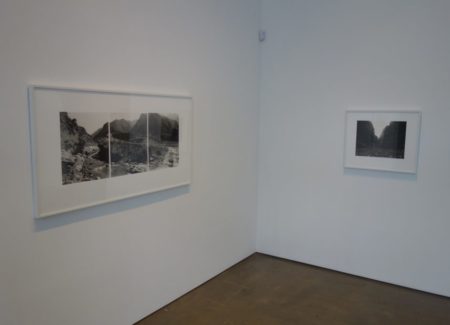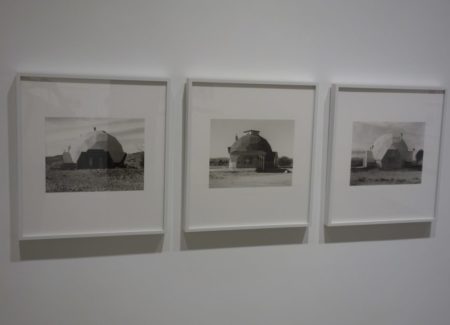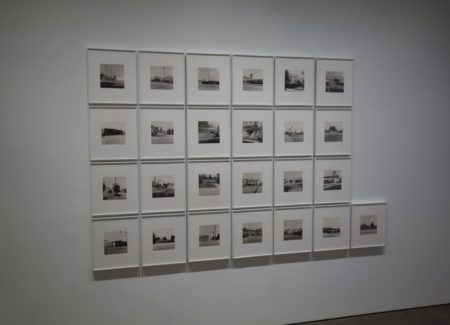JTF (just the facts): A total of 85 black-and-white photographs (gelatin silver on archival rag board) displayed as individual prints (5), as triptychs (3) or in grids that number between 5 and 25. The works are mounted on four white walls of the East and West gallery as well as on one wall of the viewing room and in a niche known as the “jewel box.” The prints vary in size, from 8×10 to 16×20 ins., and are dated between 1996-2016, with one negative from 1995 and another from 1996 printed in 2017. All are available in editions that range from 3 (with 2 APs) to 10 (with 2 APs). (Installation shots below.)
Comments/Context: Several years ago the graphic designer Jonathan Hull devised a map of places around the U.S. with Hellish names (here). The geographic dispersal and sheer numbers surprised him. Who knew that Connecticut, for instance, has been such a mephitic hideout for Satan and his minions? Five cities have a “Devil’s Den,” four others a “Devil’s Backbone.” Simsbury has a “Hell Hole” and Plainfield a “Hell’s Hollow Brook.”
North America must have been so forbidding for Bible-besotted travelers in the 18th and 19th century that it didn’t take much for them to see in any swirling eddy or crooked outcrop the handiwork of Lucifer. Whether these names originated with sailors and settlers, ministers and prospectors, or government-sponsored map-mappers, they reflected a watchful respect for Nature as a capricious force that could drown or desiccate you.
This devilish idea is the basis for Mark Ruwedel’s latest show at Yossi Milo. As the title suggests, it has two parts: older landscapes from the 1990s (the “Hell” half of the show); and newer portraits of abandoned dwellings from 2013-15 (the “Home” half). Both series were done in the Western states of Nevada, Utah, Oregon, and in California, where he now lives. The gallery has partaken of the infernal mood by mounting a set of Ruwedel’s Furnaces (beehive-like ovens at saw mills arranged in Becher-like grids) from 1996-2008 in the viewing room.
Pictures of Hell—one of his three decades-long landscape projects (along with The Ice Age and Westward the Course of Empire)—views the Western landscape as empty but unawesome space, without either majesty or terror. The series is as also about the historical distance we have traveled as a society from the people who named these places. The catastrophe-minded geologist Clarence King may have seen Satan at work on the sun-blasted deserts of the West when he surveyed them in the 1860s and ‘70s. But many of these formations are now tourist attractions, as any backpacker knows who has walked through Devil’s Garden in Arches National Park.
The extended series (only sampled here) includes 27 Devil’s Gates, 8 Hell’s Gates, 12 Devil’s Canyons, several Devil’s Gardens, a Devil’s Punchbowl, and a Hell’s Half Acres. Whatever sinister atmosphere they once possessed, however, is hard to find in Ruwedel’s photographs. They’re mostly nondescript places and, even if they once presented obstacles to settlement or routes of transportation, they seem to be without strategic or financial importance now.
Like other New (and Old) Topographers, Ruwedel is drawn to the nonsensational, to workaday plots of land or perspectives without prepossessing landmarks or giveaways. The challenge for him as a photographer, as it was for one of his heroes, Timothy O’Sullivan, is to make something lasting or at least salvageable out of a prospect that others would avoid as worthless. He prefers the ugly truth over airy fantasy, and he encourages us to like it, too. There is invariably something elegant in his prints—in the pattern of broken sun and shadow on a dirt road west of nowhere or in the velvety texture of a parking lot—to admire.
The Home portion of the show is more object-oriented and finds him mulling over his decision to settle in southern California. Wonder Valley Survey is a series of 8x10s that depict tiny, one-story homes in the desert north of Squaw Valley. Inexpensive though they must have been to construct and maintain, these homes have been abandoned, the former owners defeated by an unknown array of forces. The occupants of Three Domes, each home a variation on Buckminster Fuller’s geodesic design, were no luckier. They were defeated, too.
The long, tall shadow of Edward Ruscha looms over the back room. More than any photographer, he revealed the glamour and romance of post-war Los Angeles in all its washed-out, speckled gray banality. Three of his books have served as navigational guides for Ruwedel as he has settled into his new and unfamiliar home. Opportunities Realized, the second of these three works, is the largest of the many grids in the show. The 25 vacant lots that Ruscha cataloged in his 1970 book, Real Estate Opportunities, were revisited by Ruwedel in 2014. Using the same model camera, and photographing places from a similar vantage point, he found—as might be expected—that some of the lots have sprouted homes and others have remained empty.
What is most ingenious and witty about these homages, though, is that Ruwedel is treating Ruscha precisely the way that Mark Klett, Gordon Bushaw, Joann Verburg, Ellen Manchester, and Rick Dingus treated the 19th century survey photographers of the West in their Second View: The Rephotographic Survey Project. Having documented L.A. boulevards and parking lots decades ago with unflashy attitude and doggedness, Ruscha is an American pioneer in the eyes of Ruwedel—another Timothy O’Sullivan.
It should be clear by now that Ruwedel (b. 1954) is old school and not about to change his ways of working. He has shot in color but prefers black-and-white and continues to arrange his prints in grids—automatic comparisons to the Bechers be damned—and even to make 8x10s!
The grim joke of the show’s title is that Hell and Home are not so different here. Not many living things are having an easy time of it in these rocky landscapes. But the people who set up house in the desert, believing they could scratch out a modest living or raise a family, may be worse off for having tried and failed. They may have described their own lives as hellish.
Throughout his career Ruwedel has chronicled the physical effects of the winds that have buffeted and shaped America in its history, the economic downturns as well as slower, geologic erosions. Like many other photographers—and novelists—he would rather tell the stories of the losers than the winners.
As a new research branch of his project, he might chart real estate prices in some of these infernal places across the country. Is having the Devil as a previous tenant in your town a detriment for potential buyers or can it be a selling point, like bed-and-breakfasts that claim they are haunted by a ghost? It can’t be easy to sell property in Hell, California at any price, whereas Hell, Michigan has embraced its name. Not only do they advertize with signs that say, “Go to Hell,” they also boast that the place does freeze over in winter. People will do their best to make a home for themselves anywhere, even in Hell.
Collector’s POV: Prices range from $2500 for Gates of Hell (individual prints) to $30000 for Furnaces (a set of 12 prints) and Wonder Valley Survey (a set of 15 prints) and $40000 for Opportunities Realized (a set of 25 prints). Ruwedel’s work has little secondary market history, so gallery retail likely remains the best option for those collectors interested in following up.















